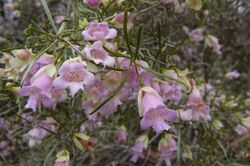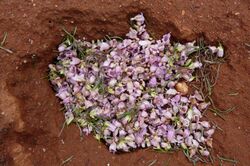Biology:Eremophila sturtii
| Turpentine bush | |
|---|---|

| |
| Eremophila sturtii flowers and leaves | |
| Scientific classification | |
| Kingdom: | Plantae |
| Clade: | Tracheophytes |
| Clade: | Angiosperms |
| Clade: | Eudicots |
| Clade: | Asterids |
| Order: | Lamiales |
| Family: | Scrophulariaceae |
| Genus: | Eremophila |
| Species: | E. sturtii
|
| Binomial name | |
| Eremophila sturtii R.Br.[1]
| |
| Synonyms[1] | |
| |
Eremophila sturtii, commonly known as turpentine bush, is a shrub endemic to Australia . Aboriginal people give it names including munyunpa and watara.[2] A medium to large shrub, it is often multi-stemmed and has narrow leaves and lilac-coloured to pale mauve flowers. It is widespread and common in the drier parts of Australia and occurs in all mainland states, although it is endangered in Victoria. It is sometimes regarded as a weed, partly because of its ability to reproduce vegetatively.
Description
Eremophila sturtii is a shrub growing to a height of 1–3 m (3–10 ft) with many slender branches and dark grey, deeply fissured bark on older specimens. Its leaves are arranged alternately, bright green, slightly aromatic, mostly 10–50 mm (0.4–2 in) long and 0.5–2.5 mm (0.02–0.1 in) wide. They are also linear in shape with a curved, hooked end, glabrous, shiny and often sticky due to the presence of resin.[3][4][5][6]
The flowers are borne singly, rarely in pairs, on curved stalks 6–18 mm (0.2–0.7 in) long in the leaf axils. There are 5 cream-coloured to pinkish-purple, lance-shaped to egg-shaped sepals. The sepals are sticky, mostly glabrous and usually 7–11 mm (0.3–0.4 in) long. The five petals are 12–18 mm (0.5–0.7 in) and joined at their lower end, forming a bell-shaped tube. The petal tube is lilac-coloured to mauve or pinkish purple, rarely white and is spotted with purple. The petal tube has glandular hairs on the outside but the outside of the lobes is often covered with many long, thin hairs. The inside of the lobes is glabrous, except for the lower one which is covered with long thin hairs. The inside of the petal tube is filled with long, soft hairs. The 4 stamens do not protrude beyond the end of the petal tube. Flowering occurs from July to October and is followed by fruit which are hard, hairy, oval shaped and 3.5–5 mm (0.1–0.2 in) long.[3][4][5][6][7]
Taxonomy and naming
Eremophila sturtii was first formally described by Robert Brown in 1849 and the description was published in Charles Sturt's Narrative of an expedition into Central Australia[8][9] and named for Captain Charles Sturt in honour of his explorations in central Australia.[3]
There are many common names for E. sturtii, including turpentine bush, narrow-leaved emu bush, budda bush, small sandalwood, scented sandalwood, turpentine emu bush,[3] narrow-leaved emu-bush[10] and kerosene bush.[11] Pitjantjatjara people know the plant as munyunpa or watara, Anmatyerre people as atyer or kwenthey and the Arrernte people as ilpurt-ilpurte.[10]
Distribution
Eremophila sturtii is common and widespread through south west Queensland, western New South Wales and eastern South Australia. There is a small population in the far north-west of Victoria.[12] There is also a disjunct distribution in south-central Northern Territory, eastern Western Australia and north central South Australia.[3] It grows on clay soils on plains, red sandy soils of sand plains and on low shaley hills.[2]
Ecology
Like its close relative E. mitchellii, E. sturtii is a weed in some pastoral areas. It can form root suckers enabling it to form extensive colonies.[3] When above-ground parts of the plant are removed, it regrows vigorously from its roots and it is also difficult to control using fire or herbicide.[13] Legislation relating to the limiting of land clearing exempts E.sturtii, E. mitchellii and some other native species.[14]
Research into methods to control the spread of E. sturtii initially focused on regeneration following severe fires in 1974 in the Ivanhoe (NSW) district. The results showed that E. sturtii was particularly good at regeneration after fire and ‘recovery seemed independent of burning conditions and shrub size’.[15] Later studies of ‘grubbing’ techniques in the Cobar region of New South Wales have shown that ripping the plants from the soil, and then covering the exposed roots with soil, has been the most effective method of control.[13] Concern has been raised about the consequences of removal of woody weeds. As a dominant species they are stable in the environment. What happens, in terms of replacement, in the event of removal is still unclear.[16] A native scale insect in the genus Pulvinaria has been shown to be valuable in the control of E. sturtii and E. mitchellii but to be effective, the insect needs to be manually transferred.[17]
Conservation
This species is classified as "not threatened" by the Government of Western Australia Department of Parks and Wildlife[18] and "of least concern" in the Northern Territory.[10] It is listed as endangered in Victoria.[12]
Uses
Medicine
Aboriginal Australians used munyunpa as an infusion or in the form of ashes to treat backache and the leaves as an infusion or a decoction to treat sores, cuts, head colds, sore eyes or diarrhoea.[11] Evidence exists that this plant was used in the treatment of coughs and colds by grinding the leaves and mixing with fat to spread on the skin.[19] Recent research has focused on the pharmacology of many eremophila species, including E. sturtii. Isolating compounds found in endemic species of plants is becoming prevalent in the search for means to assist in the fight against antibiotic resistant bacteria. This is a costly and time consuming practice. Research into E. sturtii has been focused on the development of an antibacterial layer that can be applied to medical implants to prevent infection.[20][21][22]
Horticulture
The Society for Growing Australian Plants (now Australian Native Plants Society (Australia)) Eremophila Study Group has focused attention on propagating eremophila species with varying degrees of success.[23] This eremophile has been seen as a highly desirable garden plant because of its density of flowers. "It resembles a bridal veil blowing in the wind when in flower".[24] Propagation from cuttings is very difficult for this species and Grafting onto Myoporum rootstock is preferred for this species in domestic gardens to avoid the problems of suckering. Its frost tolerance, and hardiness in drought, makes it a species that is noted for inclusion in difficult gardens, however it can cause skin irritation in some people.[24]
Other uses
Eremophila sturtii has insect-repellant properties and the branches were sometimes used by European settlers to thatch meat-houses.[11] Aboriginal people used the plant for weapons and implements, shade and shelter, as fish poison and to make fish traps. They also used the fruits for food.[10]
References
- ↑ 1.0 1.1 "Eremophila sturtii". Australian Plant Census. https://biodiversity.org.au/nsl/services/apc-format/display/115652. Retrieved 1 September 2020.
- ↑ 2.0 2.1 Kutsche, Frank (2003). Field Guide to the Plants of Outback South Australia. South Australia: Department of Environment and Heritage, South Australia. pp. 80. ISBN 0759010528.
- ↑ 3.0 3.1 3.2 3.3 3.4 3.5 Chinnock, R.J. (Bob) (2007). Eremophila and allied genera : a monograph of the plant family Myoporaceae (1st ed.). Dural, NSW: Rosenberg. pp. 216–218. ISBN 9781877058165.
- ↑ 4.0 4.1 Brown, Andrew; Buirchell, Bevan (2011). A field guide to the eremophilas of Western Australia (1st ed.). Hamilton Hill, W.A.: Simon Nevill Publications. p. 267. ISBN 9780980348156.
- ↑ 5.0 5.1 Chinnock, Robert. "Eremophila sturtii". Royal Botanic Garden Sydney; plantnet. http://plantnet.rbgsyd.nsw.gov.au/cgi-bin/NSWfl.pl?page=nswfl&lvl=sp&name=Eremophila~sturtii. Retrieved 18 March 2016.
- ↑ 6.0 6.1 "Eremophila sturtii". Electronic Flora of South Australia. http://www.flora.sa.gov.au/cgi-bin/speciesfacts_display.cgi?form=speciesfacts&family=&genus=Eremophila&species=sturtii&iname=&submit=Display. Retrieved 7 January 2016.
- ↑ Cunningham, G.M. (1981). Plants of Western New South Wales. Australia: Soil Conservation Service of New South Wales. pp. 610–611. ISBN 0724020039.
- ↑ "Eremophila sturtii". APNI. https://id.biodiversity.org.au/instance/apni/550277. Retrieved 25 December 2016.
- ↑ Sturt, Charles (1849). Narrative of an Expedition into Central Australia (Volume 2). Bond Street, London: T. and W. Boone. p. 85. http://adc.library.usyd.edu.au/data-2/p00102.pdf. Retrieved 7 January 2016.
- ↑ 10.0 10.1 10.2 10.3 "Eremophila sturtii". Northern Territory flora online. http://eflora.nt.gov.au/factsheetaspdf?id=3706. Retrieved 18 March 2016.
- ↑ 11.0 11.1 11.2 Richmond, G.S. (1993). "A review of the use of Eremophila (Myoporaceae) by Australian Aborigines". Journal of the Adelaide Botanic Garden 15 (2): 101–107. http://www.environment.sa.gov.au/files/6207eea7-309c-445e-9fc4-9f8600c377a2/JABG15P101_Richmond.pdf.
- ↑ 12.0 12.1 "Eremophila sturtii". Royal Botanic Gardens Victoria: VicFlora. http://data.rbg.vic.gov.au/vicflora/flora/taxon/27de204f-06c4-4212-a2cc-bb17e5eda01b. Retrieved 8 January 2016.
- ↑ 13.0 13.1 Wiedemann, H. T.; Kelly, P. J. (2001). "Turpentine (Eremophila sturtii) control by mechanical uprooting". The Rangeland Journal 23 (2): 173–181. doi:10.1071/RJ01004.
- ↑ "Native Vegetation Conservation (Savings and Transitional) Amendment (Western Division) Regulation 2004". Australasian Legal Information Institute. http://www.austlii.edu.au/au/legis/nsw/num_reg/nvatadr20042004277795.pdf. Retrieved 19 March 2016.
- ↑ Wilson, Alan Durham; Mulham, William Edward (1976). "A survey of the regeneration of some problem shrubs and trees after wildfire in western New South Wales.". The Rangeland Journal 1 (4): 363–368. doi:10.1071/RJ9790363.
- ↑ Page, M; Beeton, RJS; Mott, JJ (2000). "Grass response to shrub removal in two semi-arid vegetation communities.". The Rangeland Journal 22 (2): 220–224. doi:10.1071/RJ0000220.
- ↑ Cullen, Jim; McFadyen, Rachel; Julien, Mic (2012). Biological control of weeds in Australia. Collingwood, Vic.: CSIRO Publishing. pp. 256–258. ISBN 9780643099937.
- ↑ "Eremophila sturtii". FloraBase. Western Australian Government Department of Parks and Wildlife. https://florabase.dpaw.wa.gov.au/browse/profile/37300.
- ↑ Chinnock, Robert (2007). Eremophila and allied genera. South Australia: Rosenberg Publishing. pp. 75. ISBN 9781877058165.
- ↑ Greisser, H.J.; Ys, H.; Ndi, C.P.; Britcher, L. (2008). "Combating infections at Biomedical Implants and Devices by Antibacterial Coatings". Chemistry in Australia 75: 5–8.
- ↑ Ndi, C.P.; Semple, H.J.; Greisser, H.J.; Barton, M.D. (2007). "Antimicrobial activity of some plant species from the Australian genus Eremophila". Journal of Basic Microbiology 47 (2): 158–164. doi:10.1002/jobm.200610262. PMID 17440918.
- ↑ Ndi, C.P.; Semple, S.J.; Greisser, H.J.; Pyke, S.M.; Barton, M.D. (2007). "Antimicrobial compounds from the Australian desert plant Eremophila neglecta". Journal of Natural Products 70 (9): 1439–1443. doi:10.1021/np070180r. PMID 17844993.
- ↑ Jennings, Colin. "Eremophila: The Emu Bush". Australian Native Plants Society Australia. http://anpsa.org.au/APOL22/jun01-2.html. Retrieved 8 January 2016.
- ↑ 24.0 24.1 Boschen, Norma (2008). Australia's Eremophilas: changing gardens for a changing climate. Melbourne: Blooming Books. pp. 172–173. ISBN 9781876473655.
Wikidata ☰ Q5385587 entry
 |



